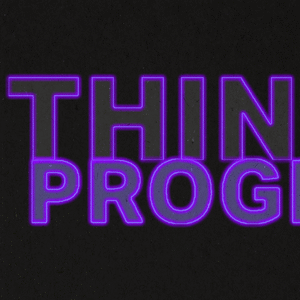The public explanation for why ThinkProgress, the recently shuttered news arm of the Center for American Progress, was forced to close up shop has mostly centered around the site’s dwindling advertising revenues and the instability that caused.
But documents obtained by The Daily Beast point to another culprit, one that raises larger questions about the sustainability of progressive outlets in the news ecosystem. A lack of support from direct and indirect donors played a far more critical role in ThinkProgress’ demise than has previously been reported.
Started in 2005, ThinkProgress has never been a profitable enterprise. But its finances hit a particular rough patch during the last few years. A document put together in May by Navin Nayak, the president of the Center for American Progress Action Fund, showed that in 2017, the site ran a roughly $625,000 deficit. Its ad revenues topped $1.19 million that year, which helped the gap from being even larger. But it also received a $1,000,000 donation from an anonymous “major donor.”
ADVERTISEMENT
By 2018, ad revenue had dipped to roughy $695,000—prompting internal concern about long-term viability. But making matters worse, that $1-million donation was gone, creating a deficit that ballooned to $2.4 million.
Things could have gone even further south, according to Nayak’s doc. That same year, more than $600,000 flowed into the site’s coffers from “ThinkProgress Grants,” which were donations that were made to CAP for work on specific ThinkProgress projects. ThinkProgress also received more than $460,000 in funds from other CAP teams and programs that it used to fund its work (think: an environmental group giving a million dollars to the think tank and ThinkProgress getting a portion of that for climate-related reporting).
But by 2019, those revenue streams appeared to be drying up too. The document Nayak produced showed that ThinkProgress Grants were on track to dip to $64,000, while funds from CAP’s other teams were scheduled to fall to $277,000. Combined, that meant ThinkProgress was getting roughly $719,000 less than it had the year prior. On top of that, there was still no money coming in from major donors.
The result—combined with still-falling ad revenues—was a massive projected deficit. Despite having an expected 5 percent drop in staff and overhead costs, the site was on pace to have a $3 million budget shortfall in 2019, according to the doc Nayak produced.
That document proved to be a macabre turning point for the progressive news site, sources who were there say. Over the course of the subsequent weeks and months, ThinkProgress would shed staff, be put up for sale, and, ultimately, shuttered. Through it all, CAP pointed to a slippage in ad revenues as the main reason for the site’s demise.
“Like most media organizations, ThinkProgress has relied on advertising revenue as a major source of funding, increasingly subject to the behavior of social-media platforms and their decisions on news distribution,” Nayak told The Daily Beast back in early June. He would strike a similar note when ThinkProgress was forced to close earlier this month. “Like so many other news outlets that have relied on advertising to fund its work,” he said then, “ThinkProgress has seen a significant drop in revenue in recent years, along with other financial strains."
To underscore these assertions, Nayak noted in his May budget document that advertising revenue in 2019 was expected to come in under $500,000, which would have been the budgetary equivalent of a five-alarm fire.
But that projection turned out to be more dire than what ended up taking place. A new internal budget document obtained by The Daily Beast, and authenticated by two sources, showed that ThinkProgress was on pace to bring in $618,000 in ad revenue in 2019. That uptick was credited to a better-than-expected June and July. Ad revenues would still fall short of what the site brought in in 2018 and well short of what it had budgeted for in 2019. But it was roughly $120,000 more than had been projected when Nayak had crunched the numbers in May.
By no means did those numbers mean that ThinkProgress was on solid financial footing. Indeed, top officials at CAP still concluded that without a more significant uptick in ad revenues the think tank could not rationalize paying the tab to keep the site afloat. A third budget document, provided by officials at CAP showed that from 2012 to 2017, the think tank never had to cover more than a $915,000 shortfall for ThinkProgress. But in 2018 that shortfall skyrocketed north of $2.3 million and in 2019 it was projected to climb even higher.
But for many former staffers, the numbers added credence to a common lament, namely that the death of ThinkProgress was not an isolated moment of a struggling news site but a story of how Democratic institutions, foundations, and patrons don’t see progressive media as a venture worth funding.
“The projections gave many of us the impression that the financial situation wasn’t quite as straightforward as CAP executives represented it to be,” a former ThinkProgress employee told The Daily Beast. “The budget gap was mostly due to a decline in foundation and major donor support, rather than a decline in TP’s ability to generate revenue through advertising and membership.”
The perceived discrepancies between some of CAP’s public statements and the private reality ended up leading to an erosion of trust between some of the members of the newsroom and the think tank. That was compounded by CAP’s initial decision to retain the ThinkProgress website as a repository for policy analysis from think tank scholars.
“The fact that they folded it back into CAP proves this was never about money,” a former staffer said. “It was about control and power.”
Over a week ago, the site was archived following pressure from the union representing former ThinkProgress employees.
Officials at CAP declined requests to comment. But even in its final days, the site was hampered by the unwillingness of funders to throw it a lifeline. According to several sources, at least three major financial backers were approached by CAP about buying the site in the weeks before it closed. But none wanted to take on the financial burden. And one major Democratic fundraiser told The Daily Beast that there was not much of an aggressive approach by CAP to find a bidder—at least in his extensive network.
One name often discussed as a bidder was Tom Steyer, the billionaire investor who served as a member of CAP’s board. But, in June, a spokesman for Steyer told The Daily Beast that he was not interested in buying. A month later, he would enter the presidential race, during which he has spent millions on Facebook ads promoting his candidacy.
This Tuesday, Gara LaMarche, the president of Democracy Alliance, one of the party’s biggest funding operations, acknowledged the great “frustration” he felt that major donors—including George Soros—were not supporting progressive media ventures.
“I’ve worked for progressive donors for 20 years or more,” LaMarche said, “and that has been to our great cost.”









